International Finance Report: Currency Fluctuation Analysis (FIN0705)
VerifiedAdded on 2022/08/29
|10
|2526
|14
Report
AI Summary
This report analyzes currency fluctuations of the Australian Dollar (AUD), British Pound (GBP), and Chinese Yuan (CNH) against the US Dollar (USD) over a one-year period. It examines the impact of the US-China trade war, Brexit, and other economic and political factors on exchange rates. The report provides a detailed overview of the currency movements, including the impact of trade tensions, interest rate changes, and geopolitical events. It highlights the effects of economic uncertainty, government policies, and global market sentiments on the values of the chosen currencies. The analysis covers the period from January 2019 to January 2020, providing insights into the reasons behind the observed fluctuations in each currency pair, including the influence of the US-China trade war on the AUD and CNH, the impact of Brexit on the GBP, and the role of economic data releases and global events on all three currencies. The report concludes with a summary of the key drivers of currency movements and their implications for international finance.

International Finance
Paraphrase This Document
Need a fresh take? Get an instant paraphrase of this document with our AI Paraphraser
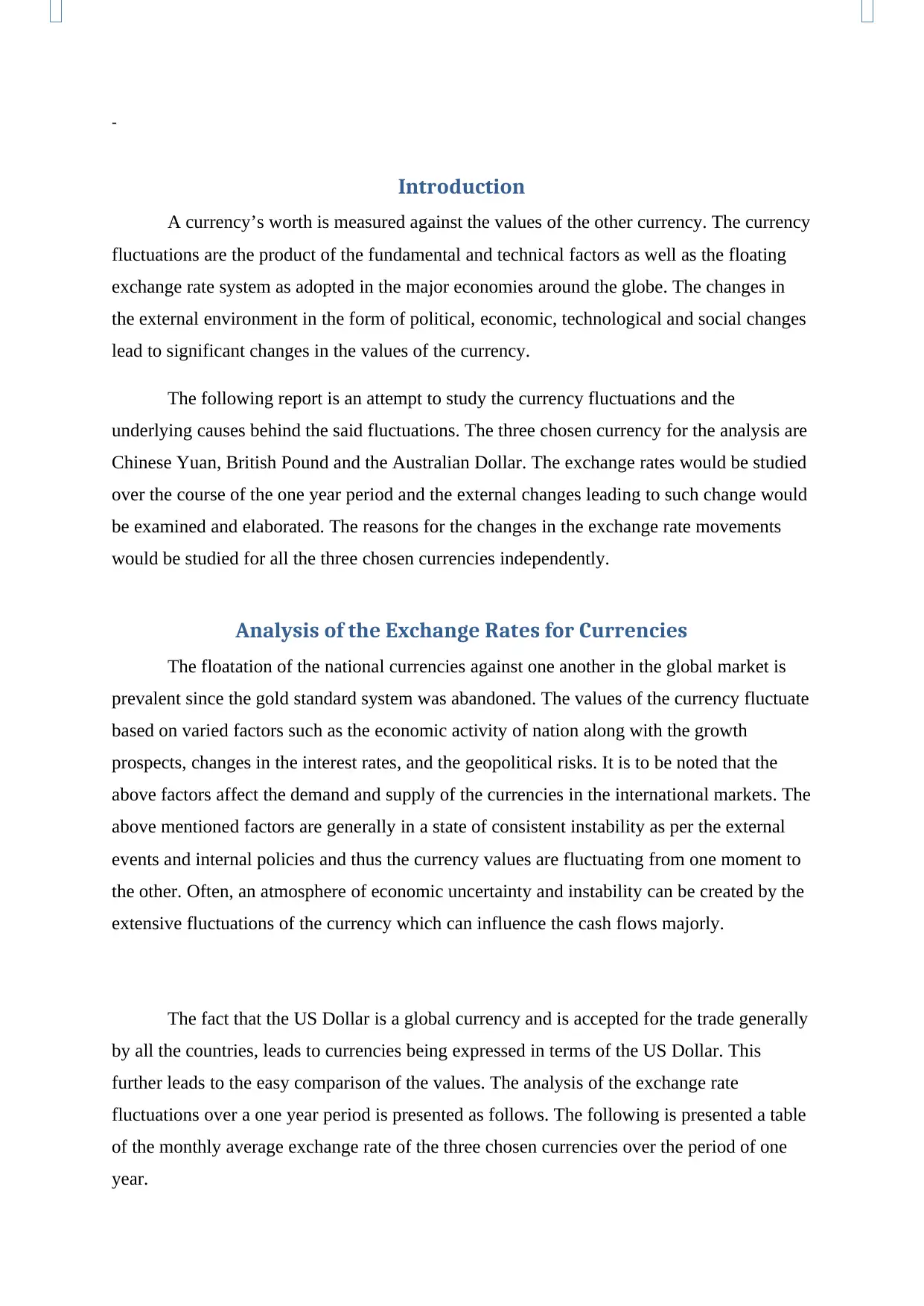
-
Introduction
A currency’s worth is measured against the values of the other currency. The currency
fluctuations are the product of the fundamental and technical factors as well as the floating
exchange rate system as adopted in the major economies around the globe. The changes in
the external environment in the form of political, economic, technological and social changes
lead to significant changes in the values of the currency.
The following report is an attempt to study the currency fluctuations and the
underlying causes behind the said fluctuations. The three chosen currency for the analysis are
Chinese Yuan, British Pound and the Australian Dollar. The exchange rates would be studied
over the course of the one year period and the external changes leading to such change would
be examined and elaborated. The reasons for the changes in the exchange rate movements
would be studied for all the three chosen currencies independently.
Analysis of the Exchange Rates for Currencies
The floatation of the national currencies against one another in the global market is
prevalent since the gold standard system was abandoned. The values of the currency fluctuate
based on varied factors such as the economic activity of nation along with the growth
prospects, changes in the interest rates, and the geopolitical risks. It is to be noted that the
above factors affect the demand and supply of the currencies in the international markets. The
above mentioned factors are generally in a state of consistent instability as per the external
events and internal policies and thus the currency values are fluctuating from one moment to
the other. Often, an atmosphere of economic uncertainty and instability can be created by the
extensive fluctuations of the currency which can influence the cash flows majorly.
The fact that the US Dollar is a global currency and is accepted for the trade generally
by all the countries, leads to currencies being expressed in terms of the US Dollar. This
further leads to the easy comparison of the values. The analysis of the exchange rate
fluctuations over a one year period is presented as follows. The following is presented a table
of the monthly average exchange rate of the three chosen currencies over the period of one
year.
Introduction
A currency’s worth is measured against the values of the other currency. The currency
fluctuations are the product of the fundamental and technical factors as well as the floating
exchange rate system as adopted in the major economies around the globe. The changes in
the external environment in the form of political, economic, technological and social changes
lead to significant changes in the values of the currency.
The following report is an attempt to study the currency fluctuations and the
underlying causes behind the said fluctuations. The three chosen currency for the analysis are
Chinese Yuan, British Pound and the Australian Dollar. The exchange rates would be studied
over the course of the one year period and the external changes leading to such change would
be examined and elaborated. The reasons for the changes in the exchange rate movements
would be studied for all the three chosen currencies independently.
Analysis of the Exchange Rates for Currencies
The floatation of the national currencies against one another in the global market is
prevalent since the gold standard system was abandoned. The values of the currency fluctuate
based on varied factors such as the economic activity of nation along with the growth
prospects, changes in the interest rates, and the geopolitical risks. It is to be noted that the
above factors affect the demand and supply of the currencies in the international markets. The
above mentioned factors are generally in a state of consistent instability as per the external
events and internal policies and thus the currency values are fluctuating from one moment to
the other. Often, an atmosphere of economic uncertainty and instability can be created by the
extensive fluctuations of the currency which can influence the cash flows majorly.
The fact that the US Dollar is a global currency and is accepted for the trade generally
by all the countries, leads to currencies being expressed in terms of the US Dollar. This
further leads to the easy comparison of the values. The analysis of the exchange rate
fluctuations over a one year period is presented as follows. The following is presented a table
of the monthly average exchange rate of the three chosen currencies over the period of one
year.
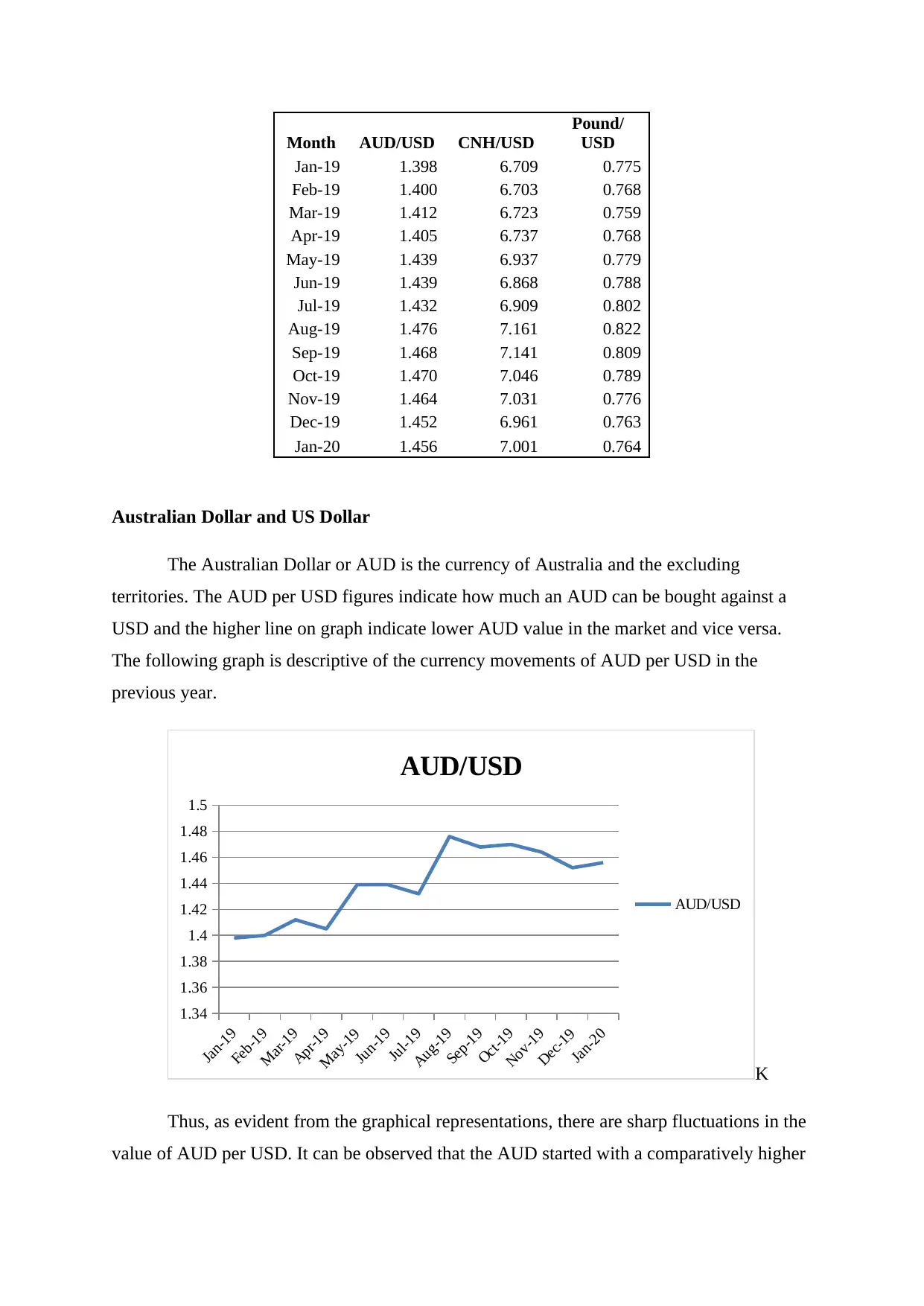
Month AUD/USD CNH/USD
Pound/
USD
Jan-19 1.398 6.709 0.775
Feb-19 1.400 6.703 0.768
Mar-19 1.412 6.723 0.759
Apr-19 1.405 6.737 0.768
May-19 1.439 6.937 0.779
Jun-19 1.439 6.868 0.788
Jul-19 1.432 6.909 0.802
Aug-19 1.476 7.161 0.822
Sep-19 1.468 7.141 0.809
Oct-19 1.470 7.046 0.789
Nov-19 1.464 7.031 0.776
Dec-19 1.452 6.961 0.763
Jan-20 1.456 7.001 0.764
Australian Dollar and US Dollar
The Australian Dollar or AUD is the currency of Australia and the excluding
territories. The AUD per USD figures indicate how much an AUD can be bought against a
USD and the higher line on graph indicate lower AUD value in the market and vice versa.
The following graph is descriptive of the currency movements of AUD per USD in the
previous year.
K
Thus, as evident from the graphical representations, there are sharp fluctuations in the
value of AUD per USD. It can be observed that the AUD started with a comparatively higher
Jan-19
Feb-19
Mar-19
Apr-19
May-19
Jun-19
Jul-19
Aug-19
Sep-19
Oct-19
Nov-19
Dec-19
Jan-20
1.34
1.36
1.38
1.4
1.42
1.44
1.46
1.48
1.5
AUD/USD
AUD/USD
Pound/
USD
Jan-19 1.398 6.709 0.775
Feb-19 1.400 6.703 0.768
Mar-19 1.412 6.723 0.759
Apr-19 1.405 6.737 0.768
May-19 1.439 6.937 0.779
Jun-19 1.439 6.868 0.788
Jul-19 1.432 6.909 0.802
Aug-19 1.476 7.161 0.822
Sep-19 1.468 7.141 0.809
Oct-19 1.470 7.046 0.789
Nov-19 1.464 7.031 0.776
Dec-19 1.452 6.961 0.763
Jan-20 1.456 7.001 0.764
Australian Dollar and US Dollar
The Australian Dollar or AUD is the currency of Australia and the excluding
territories. The AUD per USD figures indicate how much an AUD can be bought against a
USD and the higher line on graph indicate lower AUD value in the market and vice versa.
The following graph is descriptive of the currency movements of AUD per USD in the
previous year.
K
Thus, as evident from the graphical representations, there are sharp fluctuations in the
value of AUD per USD. It can be observed that the AUD started with a comparatively higher
Jan-19
Feb-19
Mar-19
Apr-19
May-19
Jun-19
Jul-19
Aug-19
Sep-19
Oct-19
Nov-19
Dec-19
Jan-20
1.34
1.36
1.38
1.4
1.42
1.44
1.46
1.48
1.5
AUD/USD
AUD/USD
⊘ This is a preview!⊘
Do you want full access?
Subscribe today to unlock all pages.

Trusted by 1+ million students worldwide
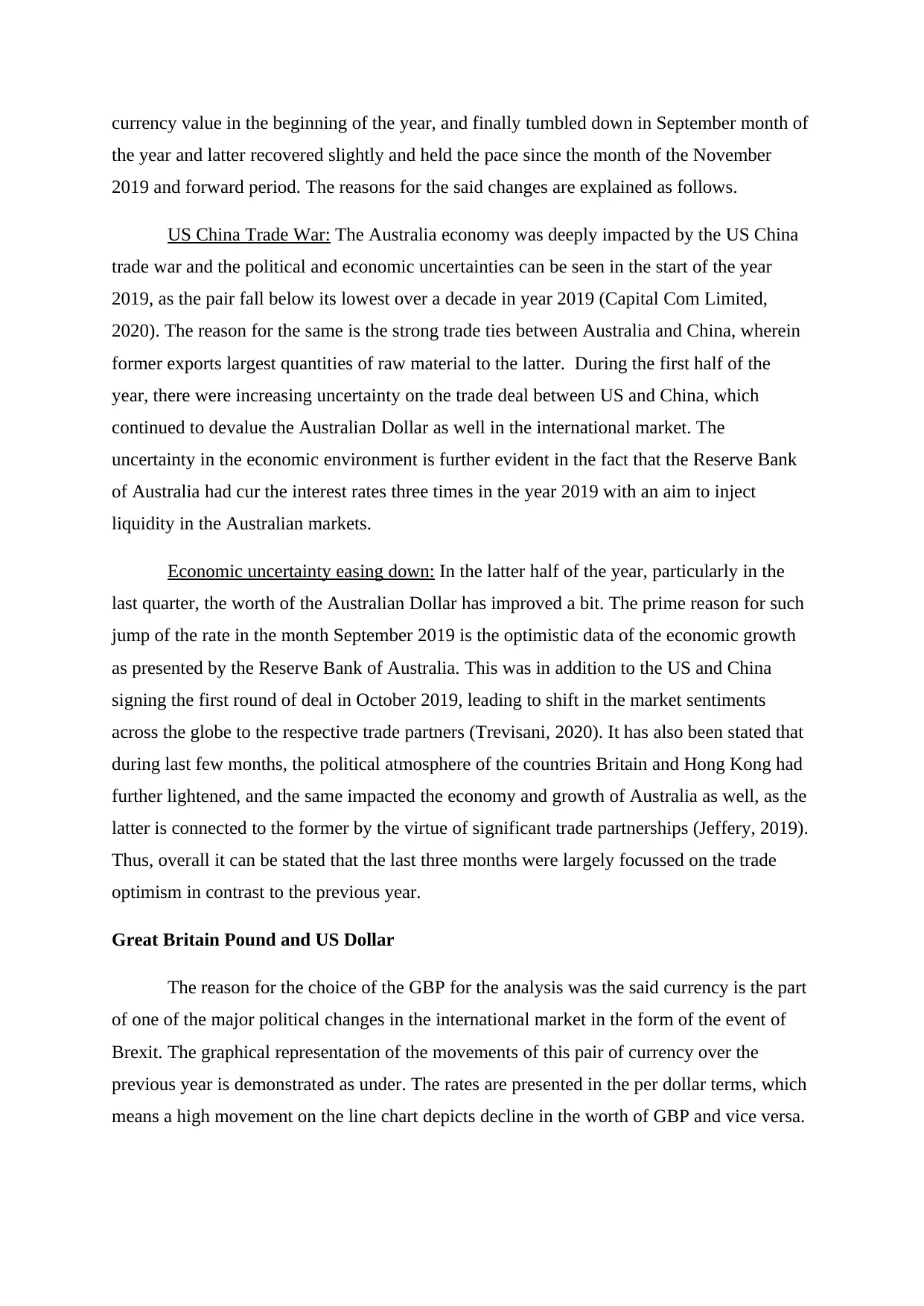
currency value in the beginning of the year, and finally tumbled down in September month of
the year and latter recovered slightly and held the pace since the month of the November
2019 and forward period. The reasons for the said changes are explained as follows.
US China Trade War: The Australia economy was deeply impacted by the US China
trade war and the political and economic uncertainties can be seen in the start of the year
2019, as the pair fall below its lowest over a decade in year 2019 (Capital Com Limited,
2020). The reason for the same is the strong trade ties between Australia and China, wherein
former exports largest quantities of raw material to the latter. During the first half of the
year, there were increasing uncertainty on the trade deal between US and China, which
continued to devalue the Australian Dollar as well in the international market. The
uncertainty in the economic environment is further evident in the fact that the Reserve Bank
of Australia had cur the interest rates three times in the year 2019 with an aim to inject
liquidity in the Australian markets.
Economic uncertainty easing down: In the latter half of the year, particularly in the
last quarter, the worth of the Australian Dollar has improved a bit. The prime reason for such
jump of the rate in the month September 2019 is the optimistic data of the economic growth
as presented by the Reserve Bank of Australia. This was in addition to the US and China
signing the first round of deal in October 2019, leading to shift in the market sentiments
across the globe to the respective trade partners (Trevisani, 2020). It has also been stated that
during last few months, the political atmosphere of the countries Britain and Hong Kong had
further lightened, and the same impacted the economy and growth of Australia as well, as the
latter is connected to the former by the virtue of significant trade partnerships (Jeffery, 2019).
Thus, overall it can be stated that the last three months were largely focussed on the trade
optimism in contrast to the previous year.
Great Britain Pound and US Dollar
The reason for the choice of the GBP for the analysis was the said currency is the part
of one of the major political changes in the international market in the form of the event of
Brexit. The graphical representation of the movements of this pair of currency over the
previous year is demonstrated as under. The rates are presented in the per dollar terms, which
means a high movement on the line chart depicts decline in the worth of GBP and vice versa.
the year and latter recovered slightly and held the pace since the month of the November
2019 and forward period. The reasons for the said changes are explained as follows.
US China Trade War: The Australia economy was deeply impacted by the US China
trade war and the political and economic uncertainties can be seen in the start of the year
2019, as the pair fall below its lowest over a decade in year 2019 (Capital Com Limited,
2020). The reason for the same is the strong trade ties between Australia and China, wherein
former exports largest quantities of raw material to the latter. During the first half of the
year, there were increasing uncertainty on the trade deal between US and China, which
continued to devalue the Australian Dollar as well in the international market. The
uncertainty in the economic environment is further evident in the fact that the Reserve Bank
of Australia had cur the interest rates three times in the year 2019 with an aim to inject
liquidity in the Australian markets.
Economic uncertainty easing down: In the latter half of the year, particularly in the
last quarter, the worth of the Australian Dollar has improved a bit. The prime reason for such
jump of the rate in the month September 2019 is the optimistic data of the economic growth
as presented by the Reserve Bank of Australia. This was in addition to the US and China
signing the first round of deal in October 2019, leading to shift in the market sentiments
across the globe to the respective trade partners (Trevisani, 2020). It has also been stated that
during last few months, the political atmosphere of the countries Britain and Hong Kong had
further lightened, and the same impacted the economy and growth of Australia as well, as the
latter is connected to the former by the virtue of significant trade partnerships (Jeffery, 2019).
Thus, overall it can be stated that the last three months were largely focussed on the trade
optimism in contrast to the previous year.
Great Britain Pound and US Dollar
The reason for the choice of the GBP for the analysis was the said currency is the part
of one of the major political changes in the international market in the form of the event of
Brexit. The graphical representation of the movements of this pair of currency over the
previous year is demonstrated as under. The rates are presented in the per dollar terms, which
means a high movement on the line chart depicts decline in the worth of GBP and vice versa.
Paraphrase This Document
Need a fresh take? Get an instant paraphrase of this document with our AI Paraphraser
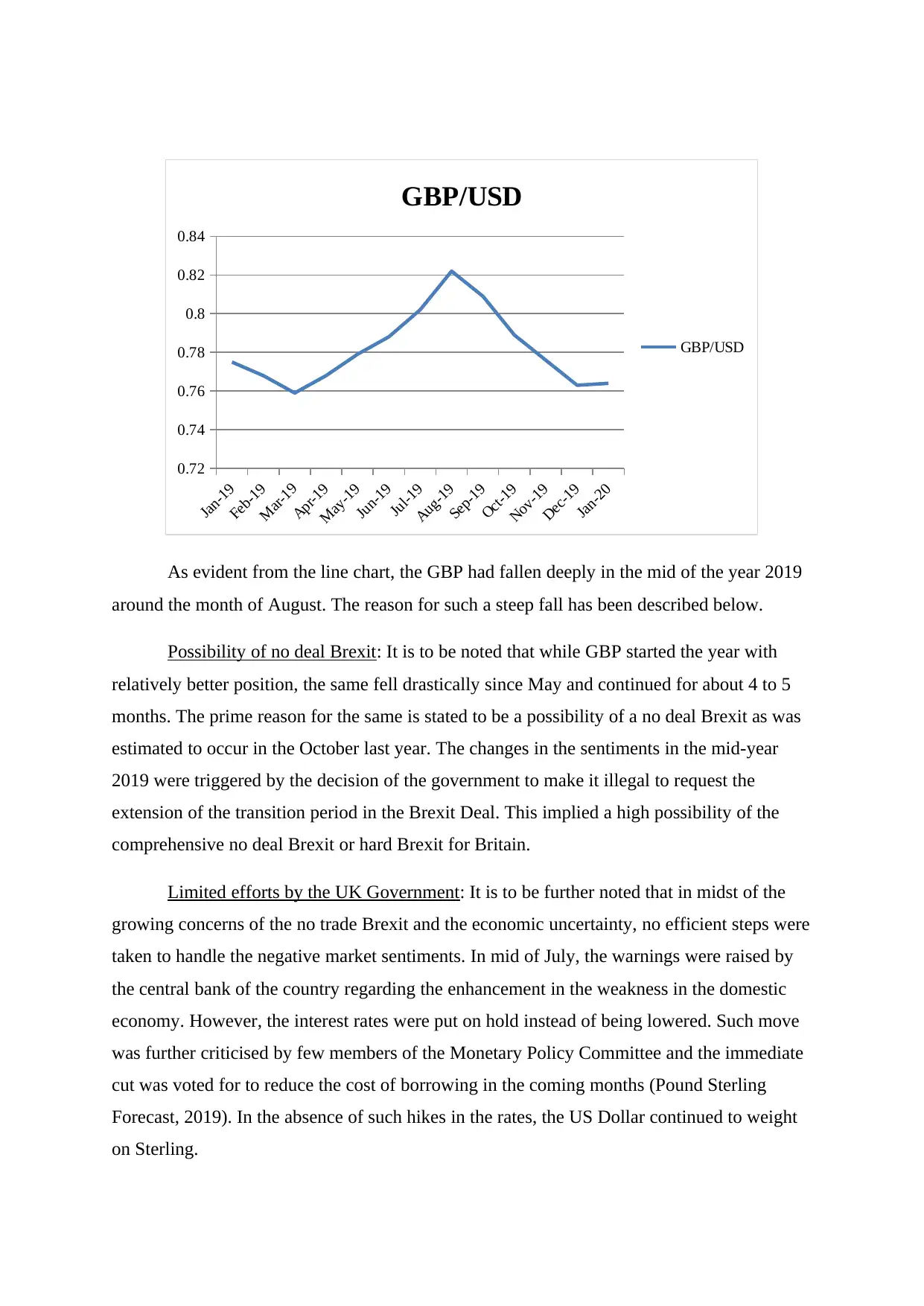
Jan-19
Feb-19
Mar-19
Apr-19
May-19
Jun-19
Jul-19
Aug-19
Sep-19
Oct-19
Nov-19
Dec-19
Jan-20
0.72
0.74
0.76
0.78
0.8
0.82
0.84
GBP/USD
GBP/USD
As evident from the line chart, the GBP had fallen deeply in the mid of the year 2019
around the month of August. The reason for such a steep fall has been described below.
Possibility of no deal Brexit: It is to be noted that while GBP started the year with
relatively better position, the same fell drastically since May and continued for about 4 to 5
months. The prime reason for the same is stated to be a possibility of a no deal Brexit as was
estimated to occur in the October last year. The changes in the sentiments in the mid-year
2019 were triggered by the decision of the government to make it illegal to request the
extension of the transition period in the Brexit Deal. This implied a high possibility of the
comprehensive no deal Brexit or hard Brexit for Britain.
Limited efforts by the UK Government: It is to be further noted that in midst of the
growing concerns of the no trade Brexit and the economic uncertainty, no efficient steps were
taken to handle the negative market sentiments. In mid of July, the warnings were raised by
the central bank of the country regarding the enhancement in the weakness in the domestic
economy. However, the interest rates were put on hold instead of being lowered. Such move
was further criticised by few members of the Monetary Policy Committee and the immediate
cut was voted for to reduce the cost of borrowing in the coming months (Pound Sterling
Forecast, 2019). In the absence of such hikes in the rates, the US Dollar continued to weight
on Sterling.
Feb-19
Mar-19
Apr-19
May-19
Jun-19
Jul-19
Aug-19
Sep-19
Oct-19
Nov-19
Dec-19
Jan-20
0.72
0.74
0.76
0.78
0.8
0.82
0.84
GBP/USD
GBP/USD
As evident from the line chart, the GBP had fallen deeply in the mid of the year 2019
around the month of August. The reason for such a steep fall has been described below.
Possibility of no deal Brexit: It is to be noted that while GBP started the year with
relatively better position, the same fell drastically since May and continued for about 4 to 5
months. The prime reason for the same is stated to be a possibility of a no deal Brexit as was
estimated to occur in the October last year. The changes in the sentiments in the mid-year
2019 were triggered by the decision of the government to make it illegal to request the
extension of the transition period in the Brexit Deal. This implied a high possibility of the
comprehensive no deal Brexit or hard Brexit for Britain.
Limited efforts by the UK Government: It is to be further noted that in midst of the
growing concerns of the no trade Brexit and the economic uncertainty, no efficient steps were
taken to handle the negative market sentiments. In mid of July, the warnings were raised by
the central bank of the country regarding the enhancement in the weakness in the domestic
economy. However, the interest rates were put on hold instead of being lowered. Such move
was further criticised by few members of the Monetary Policy Committee and the immediate
cut was voted for to reduce the cost of borrowing in the coming months (Pound Sterling
Forecast, 2019). In the absence of such hikes in the rates, the US Dollar continued to weight
on Sterling.
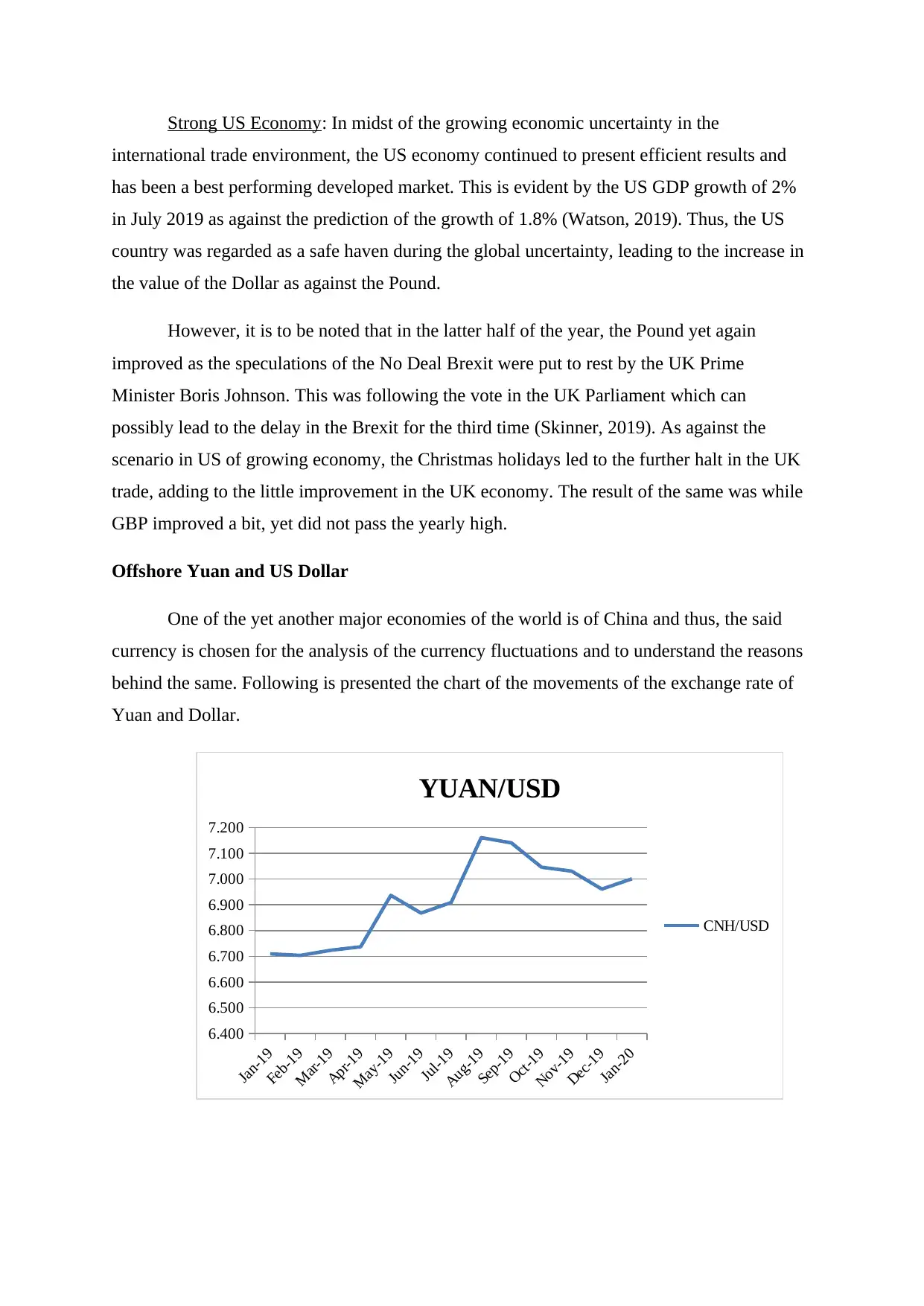
Strong US Economy: In midst of the growing economic uncertainty in the
international trade environment, the US economy continued to present efficient results and
has been a best performing developed market. This is evident by the US GDP growth of 2%
in July 2019 as against the prediction of the growth of 1.8% (Watson, 2019). Thus, the US
country was regarded as a safe haven during the global uncertainty, leading to the increase in
the value of the Dollar as against the Pound.
However, it is to be noted that in the latter half of the year, the Pound yet again
improved as the speculations of the No Deal Brexit were put to rest by the UK Prime
Minister Boris Johnson. This was following the vote in the UK Parliament which can
possibly lead to the delay in the Brexit for the third time (Skinner, 2019). As against the
scenario in US of growing economy, the Christmas holidays led to the further halt in the UK
trade, adding to the little improvement in the UK economy. The result of the same was while
GBP improved a bit, yet did not pass the yearly high.
Offshore Yuan and US Dollar
One of the yet another major economies of the world is of China and thus, the said
currency is chosen for the analysis of the currency fluctuations and to understand the reasons
behind the same. Following is presented the chart of the movements of the exchange rate of
Yuan and Dollar.
Jan-19
Feb-19
Mar-19
Apr-19
May-19
Jun-19
Jul-19
Aug-19
Sep-19
Oct-19
Nov-19
Dec-19
Jan-20
6.400
6.500
6.600
6.700
6.800
6.900
7.000
7.100
7.200
YUAN/USD
CNH/USD
international trade environment, the US economy continued to present efficient results and
has been a best performing developed market. This is evident by the US GDP growth of 2%
in July 2019 as against the prediction of the growth of 1.8% (Watson, 2019). Thus, the US
country was regarded as a safe haven during the global uncertainty, leading to the increase in
the value of the Dollar as against the Pound.
However, it is to be noted that in the latter half of the year, the Pound yet again
improved as the speculations of the No Deal Brexit were put to rest by the UK Prime
Minister Boris Johnson. This was following the vote in the UK Parliament which can
possibly lead to the delay in the Brexit for the third time (Skinner, 2019). As against the
scenario in US of growing economy, the Christmas holidays led to the further halt in the UK
trade, adding to the little improvement in the UK economy. The result of the same was while
GBP improved a bit, yet did not pass the yearly high.
Offshore Yuan and US Dollar
One of the yet another major economies of the world is of China and thus, the said
currency is chosen for the analysis of the currency fluctuations and to understand the reasons
behind the same. Following is presented the chart of the movements of the exchange rate of
Yuan and Dollar.
Jan-19
Feb-19
Mar-19
Apr-19
May-19
Jun-19
Jul-19
Aug-19
Sep-19
Oct-19
Nov-19
Dec-19
Jan-20
6.400
6.500
6.600
6.700
6.800
6.900
7.000
7.100
7.200
YUAN/USD
CNH/USD
⊘ This is a preview!⊘
Do you want full access?
Subscribe today to unlock all pages.

Trusted by 1+ million students worldwide
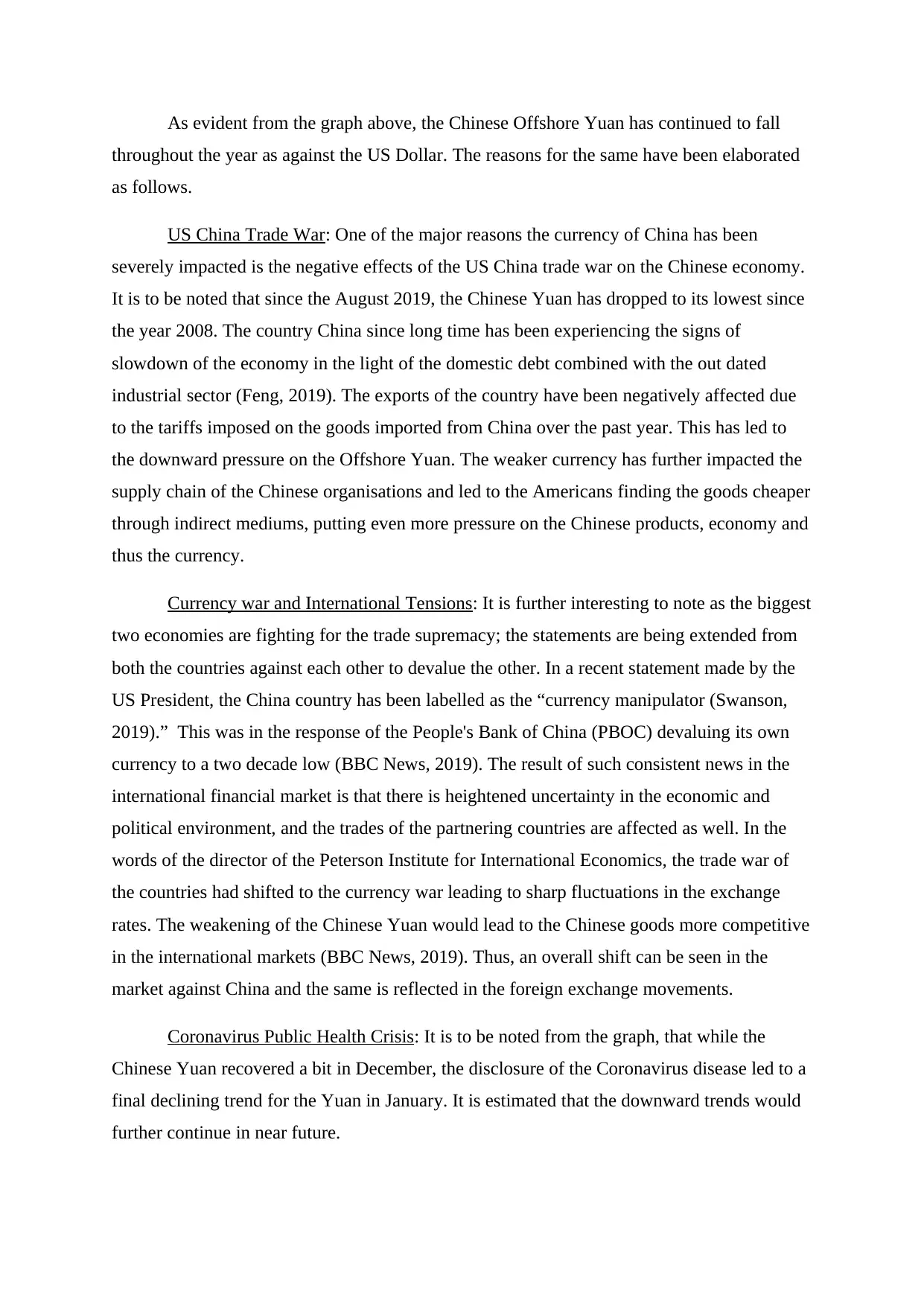
As evident from the graph above, the Chinese Offshore Yuan has continued to fall
throughout the year as against the US Dollar. The reasons for the same have been elaborated
as follows.
US China Trade War: One of the major reasons the currency of China has been
severely impacted is the negative effects of the US China trade war on the Chinese economy.
It is to be noted that since the August 2019, the Chinese Yuan has dropped to its lowest since
the year 2008. The country China since long time has been experiencing the signs of
slowdown of the economy in the light of the domestic debt combined with the out dated
industrial sector (Feng, 2019). The exports of the country have been negatively affected due
to the tariffs imposed on the goods imported from China over the past year. This has led to
the downward pressure on the Offshore Yuan. The weaker currency has further impacted the
supply chain of the Chinese organisations and led to the Americans finding the goods cheaper
through indirect mediums, putting even more pressure on the Chinese products, economy and
thus the currency.
Currency war and International Tensions: It is further interesting to note as the biggest
two economies are fighting for the trade supremacy; the statements are being extended from
both the countries against each other to devalue the other. In a recent statement made by the
US President, the China country has been labelled as the “currency manipulator (Swanson,
2019).” This was in the response of the People's Bank of China (PBOC) devaluing its own
currency to a two decade low (BBC News, 2019). The result of such consistent news in the
international financial market is that there is heightened uncertainty in the economic and
political environment, and the trades of the partnering countries are affected as well. In the
words of the director of the Peterson Institute for International Economics, the trade war of
the countries had shifted to the currency war leading to sharp fluctuations in the exchange
rates. The weakening of the Chinese Yuan would lead to the Chinese goods more competitive
in the international markets (BBC News, 2019). Thus, an overall shift can be seen in the
market against China and the same is reflected in the foreign exchange movements.
Coronavirus Public Health Crisis: It is to be noted from the graph, that while the
Chinese Yuan recovered a bit in December, the disclosure of the Coronavirus disease led to a
final declining trend for the Yuan in January. It is estimated that the downward trends would
further continue in near future.
throughout the year as against the US Dollar. The reasons for the same have been elaborated
as follows.
US China Trade War: One of the major reasons the currency of China has been
severely impacted is the negative effects of the US China trade war on the Chinese economy.
It is to be noted that since the August 2019, the Chinese Yuan has dropped to its lowest since
the year 2008. The country China since long time has been experiencing the signs of
slowdown of the economy in the light of the domestic debt combined with the out dated
industrial sector (Feng, 2019). The exports of the country have been negatively affected due
to the tariffs imposed on the goods imported from China over the past year. This has led to
the downward pressure on the Offshore Yuan. The weaker currency has further impacted the
supply chain of the Chinese organisations and led to the Americans finding the goods cheaper
through indirect mediums, putting even more pressure on the Chinese products, economy and
thus the currency.
Currency war and International Tensions: It is further interesting to note as the biggest
two economies are fighting for the trade supremacy; the statements are being extended from
both the countries against each other to devalue the other. In a recent statement made by the
US President, the China country has been labelled as the “currency manipulator (Swanson,
2019).” This was in the response of the People's Bank of China (PBOC) devaluing its own
currency to a two decade low (BBC News, 2019). The result of such consistent news in the
international financial market is that there is heightened uncertainty in the economic and
political environment, and the trades of the partnering countries are affected as well. In the
words of the director of the Peterson Institute for International Economics, the trade war of
the countries had shifted to the currency war leading to sharp fluctuations in the exchange
rates. The weakening of the Chinese Yuan would lead to the Chinese goods more competitive
in the international markets (BBC News, 2019). Thus, an overall shift can be seen in the
market against China and the same is reflected in the foreign exchange movements.
Coronavirus Public Health Crisis: It is to be noted from the graph, that while the
Chinese Yuan recovered a bit in December, the disclosure of the Coronavirus disease led to a
final declining trend for the Yuan in January. It is estimated that the downward trends would
further continue in near future.
Paraphrase This Document
Need a fresh take? Get an instant paraphrase of this document with our AI Paraphraser
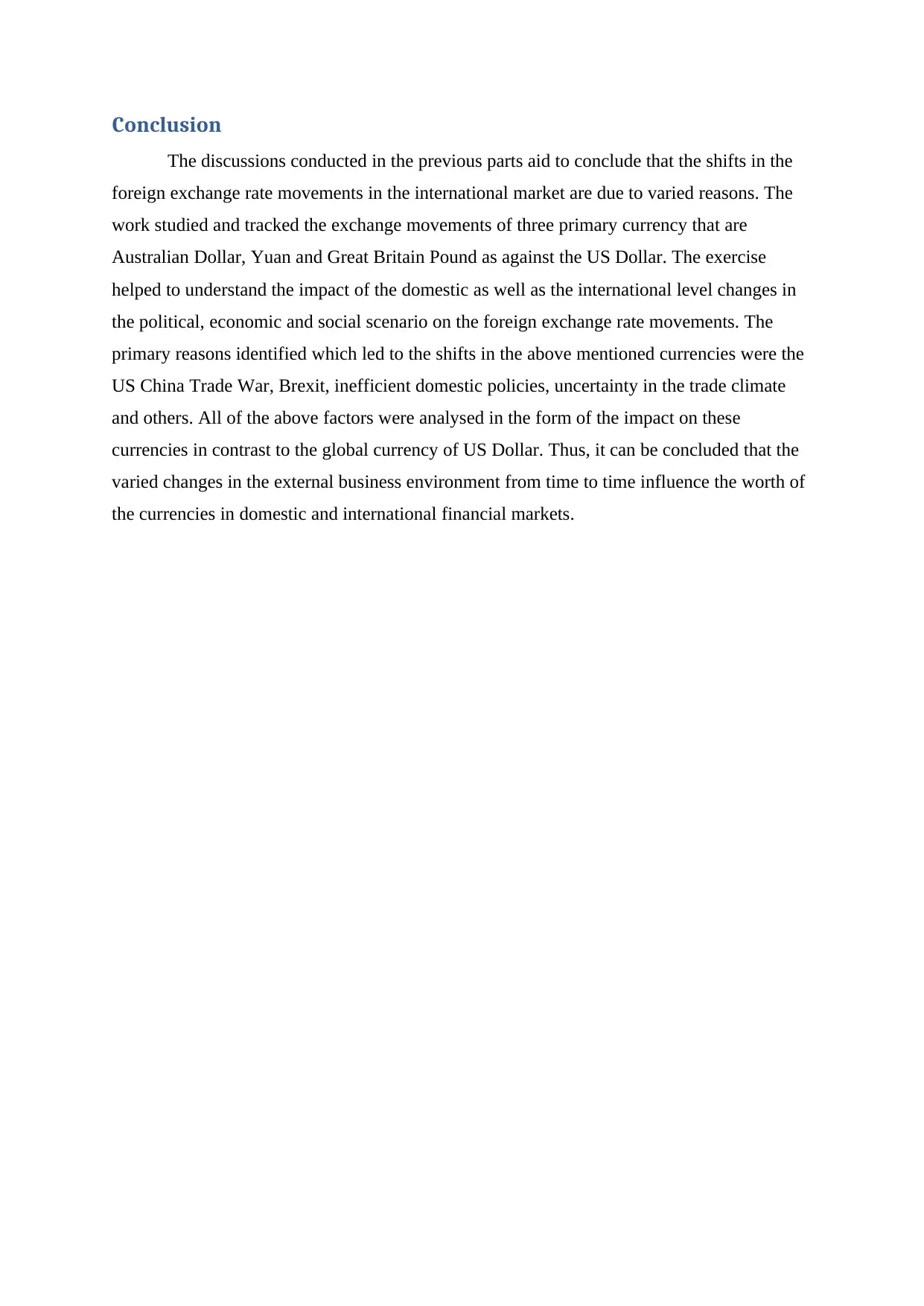
Conclusion
The discussions conducted in the previous parts aid to conclude that the shifts in the
foreign exchange rate movements in the international market are due to varied reasons. The
work studied and tracked the exchange movements of three primary currency that are
Australian Dollar, Yuan and Great Britain Pound as against the US Dollar. The exercise
helped to understand the impact of the domestic as well as the international level changes in
the political, economic and social scenario on the foreign exchange rate movements. The
primary reasons identified which led to the shifts in the above mentioned currencies were the
US China Trade War, Brexit, inefficient domestic policies, uncertainty in the trade climate
and others. All of the above factors were analysed in the form of the impact on these
currencies in contrast to the global currency of US Dollar. Thus, it can be concluded that the
varied changes in the external business environment from time to time influence the worth of
the currencies in domestic and international financial markets.
The discussions conducted in the previous parts aid to conclude that the shifts in the
foreign exchange rate movements in the international market are due to varied reasons. The
work studied and tracked the exchange movements of three primary currency that are
Australian Dollar, Yuan and Great Britain Pound as against the US Dollar. The exercise
helped to understand the impact of the domestic as well as the international level changes in
the political, economic and social scenario on the foreign exchange rate movements. The
primary reasons identified which led to the shifts in the above mentioned currencies were the
US China Trade War, Brexit, inefficient domestic policies, uncertainty in the trade climate
and others. All of the above factors were analysed in the form of the impact on these
currencies in contrast to the global currency of US Dollar. Thus, it can be concluded that the
varied changes in the external business environment from time to time influence the worth of
the currencies in domestic and international financial markets.
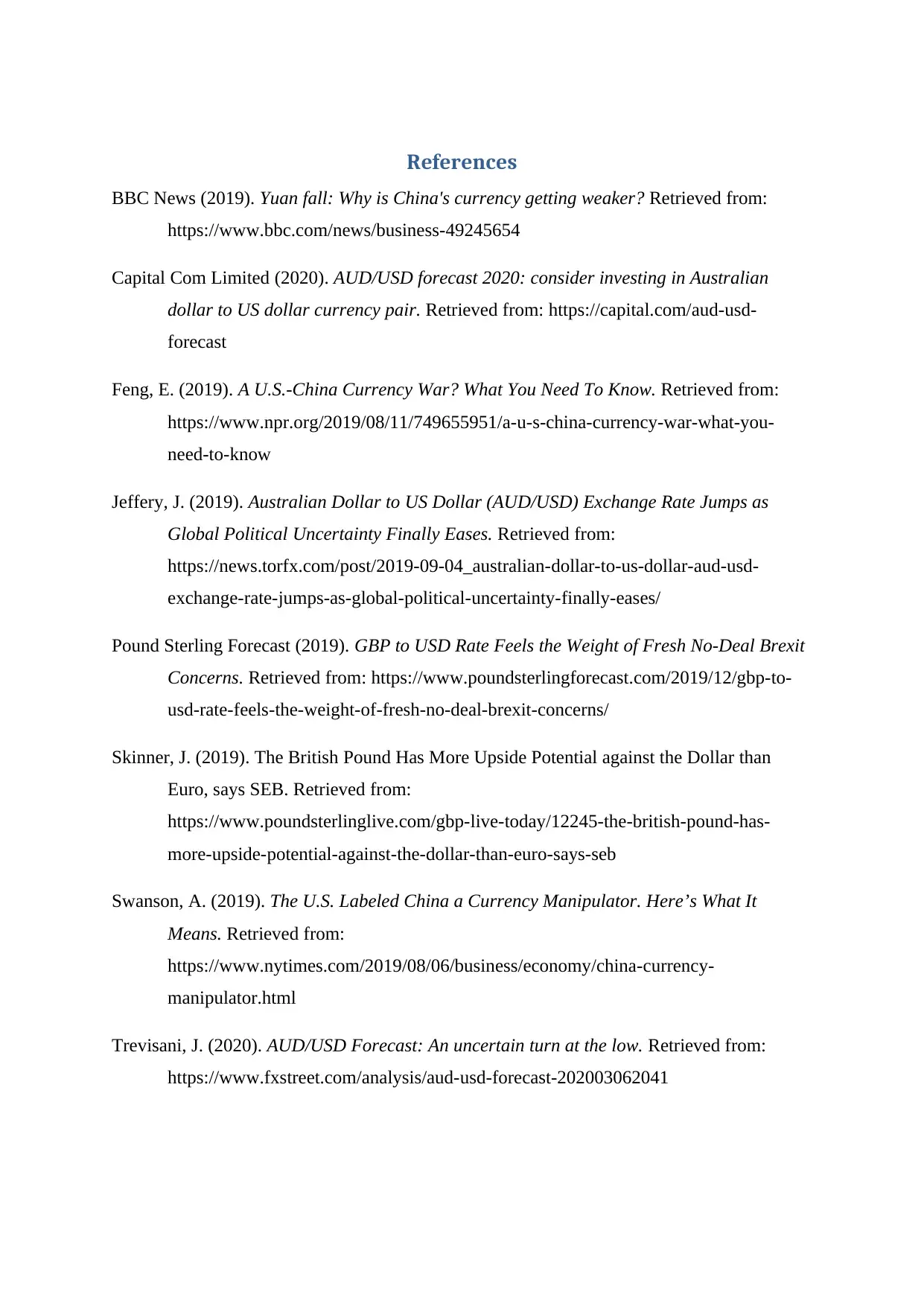
References
BBC News (2019). Yuan fall: Why is China's currency getting weaker? Retrieved from:
https://www.bbc.com/news/business-49245654
Capital Com Limited (2020). AUD/USD forecast 2020: consider investing in Australian
dollar to US dollar currency pair. Retrieved from: https://capital.com/aud-usd-
forecast
Feng, E. (2019). A U.S.-China Currency War? What You Need To Know. Retrieved from:
https://www.npr.org/2019/08/11/749655951/a-u-s-china-currency-war-what-you-
need-to-know
Jeffery, J. (2019). Australian Dollar to US Dollar (AUD/USD) Exchange Rate Jumps as
Global Political Uncertainty Finally Eases. Retrieved from:
https://news.torfx.com/post/2019-09-04_australian-dollar-to-us-dollar-aud-usd-
exchange-rate-jumps-as-global-political-uncertainty-finally-eases/
Pound Sterling Forecast (2019). GBP to USD Rate Feels the Weight of Fresh No-Deal Brexit
Concerns. Retrieved from: https://www.poundsterlingforecast.com/2019/12/gbp-to-
usd-rate-feels-the-weight-of-fresh-no-deal-brexit-concerns/
Skinner, J. (2019). The British Pound Has More Upside Potential against the Dollar than
Euro, says SEB. Retrieved from:
https://www.poundsterlinglive.com/gbp-live-today/12245-the-british-pound-has-
more-upside-potential-against-the-dollar-than-euro-says-seb
Swanson, A. (2019). The U.S. Labeled China a Currency Manipulator. Here’s What It
Means. Retrieved from:
https://www.nytimes.com/2019/08/06/business/economy/china-currency-
manipulator.html
Trevisani, J. (2020). AUD/USD Forecast: An uncertain turn at the low. Retrieved from:
https://www.fxstreet.com/analysis/aud-usd-forecast-202003062041
BBC News (2019). Yuan fall: Why is China's currency getting weaker? Retrieved from:
https://www.bbc.com/news/business-49245654
Capital Com Limited (2020). AUD/USD forecast 2020: consider investing in Australian
dollar to US dollar currency pair. Retrieved from: https://capital.com/aud-usd-
forecast
Feng, E. (2019). A U.S.-China Currency War? What You Need To Know. Retrieved from:
https://www.npr.org/2019/08/11/749655951/a-u-s-china-currency-war-what-you-
need-to-know
Jeffery, J. (2019). Australian Dollar to US Dollar (AUD/USD) Exchange Rate Jumps as
Global Political Uncertainty Finally Eases. Retrieved from:
https://news.torfx.com/post/2019-09-04_australian-dollar-to-us-dollar-aud-usd-
exchange-rate-jumps-as-global-political-uncertainty-finally-eases/
Pound Sterling Forecast (2019). GBP to USD Rate Feels the Weight of Fresh No-Deal Brexit
Concerns. Retrieved from: https://www.poundsterlingforecast.com/2019/12/gbp-to-
usd-rate-feels-the-weight-of-fresh-no-deal-brexit-concerns/
Skinner, J. (2019). The British Pound Has More Upside Potential against the Dollar than
Euro, says SEB. Retrieved from:
https://www.poundsterlinglive.com/gbp-live-today/12245-the-british-pound-has-
more-upside-potential-against-the-dollar-than-euro-says-seb
Swanson, A. (2019). The U.S. Labeled China a Currency Manipulator. Here’s What It
Means. Retrieved from:
https://www.nytimes.com/2019/08/06/business/economy/china-currency-
manipulator.html
Trevisani, J. (2020). AUD/USD Forecast: An uncertain turn at the low. Retrieved from:
https://www.fxstreet.com/analysis/aud-usd-forecast-202003062041
⊘ This is a preview!⊘
Do you want full access?
Subscribe today to unlock all pages.

Trusted by 1+ million students worldwide

Watson, J. (2019). Pound to US Dollar Outlook: GBP/USD hits lowest levels in 2-years.
Retrieved from: https://www.poundsterlingforecast.com/2019/07/pound-to-us-dollar-
outlook-gbp-usd-hits-lowest-levels-in-2-years/
Retrieved from: https://www.poundsterlingforecast.com/2019/07/pound-to-us-dollar-
outlook-gbp-usd-hits-lowest-levels-in-2-years/
1 out of 10
Related Documents
Your All-in-One AI-Powered Toolkit for Academic Success.
+13062052269
info@desklib.com
Available 24*7 on WhatsApp / Email
![[object Object]](/_next/static/media/star-bottom.7253800d.svg)
Unlock your academic potential
Copyright © 2020–2025 A2Z Services. All Rights Reserved. Developed and managed by ZUCOL.




